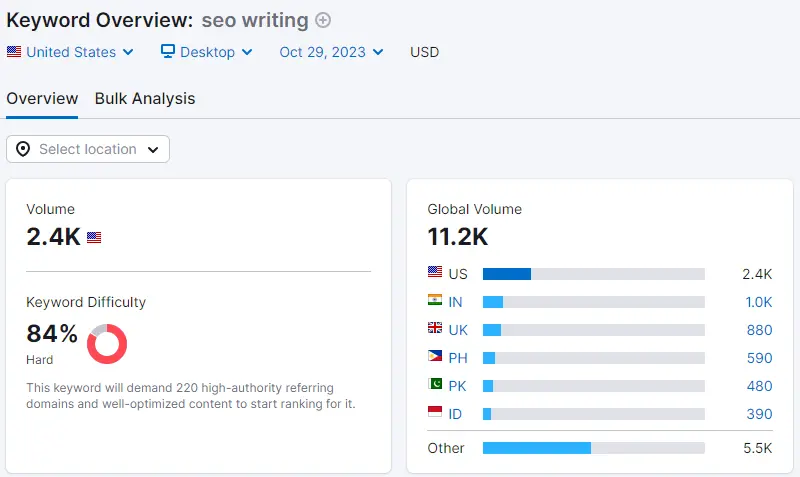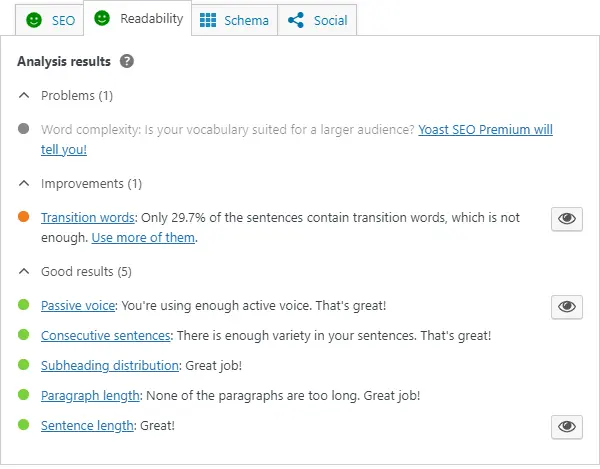Welcome to your go-to guide for understanding and mastering SEO writing. Whether you’re a newbie or a seasoned pro, this guide will give you actionable tips and insights to up your SEO game. Let’s dive in!
What are we going to cover today?
What is SEO Writing?
SEO writing is the craft of creating content that both search engines and users will love. It involves keyword research, understanding user intent, and optimizing elements like headers for better search visibility. The aim is to rank high on search engine results pages (SERPs), which in turn drives organic traffic to your website. It’s not just about getting eyes on your page; it’s about getting the right eyes – those who are genuinely interested in what you have to offer.
Now, let’s go over the core principles of SEO writing that will help you craft the next perfect piece of content!
Core Principles of SEO Writing
To be really good at SEO writing, you need to know a few important rules. These rules help you write stuff that people like to read and that also works well for search engines. When you get these rules right, your content will show up in search results and give readers what they’re looking for. It’s like hitting two birds with one stone: your readers are happy and so is Google.
Keyword and Competitor Research
Before you start writing, it’s essential to understand what your audience is interested in, and who’s there on top already. Utilize tools like Google Keyword Planner, Semrush, or Ahrefs to identify trending topics and keywords in your field. But your research shouldn’t stop at just keywords. Take a look at what your competitors are up to. Which keywords are they ranking for that you haven’t considered? What types of content are they creating? Gathering this information can give you a competitive edge, allowing you to identify gaps in the market and even improve upon what your competitors are doing.
Let’s take a look at this example, where we identified the keywords “SEO writing” and “what is SEO writing” by using Semrush:

As you can see, the search volume is quite high (also for the secondary keywords) and the difficulty is high. Still, we decided to focus on this topic because of its high relevancy to what we do – providing top-tier SEO services.
After pinpointing the right keywords, we analyzed the top-ranking websites for those terms to gain insights into the kind of content that performs well. This helps us understand what’s needed to aim for a top spot on the search engine results page (SERP). Once you’ve identified the keywords and kind of content you need to aim for, you need to make sure that you know what is the user intent.
User Intent
Understanding why people are searching online is crucial for creating content that meets their needs. User intent generally falls into four categories:
- Informational Intent: When someone is looking for answers or wants to learn something. For example, a search query like “How to improve SEO” falls under this category.
SERP Example: A how-to guide or a blog post explaining SEO techniques.
- Navigational Intent: When someone already knows the website they want to visit but uses a search engine to get there. A query like “YouTube” is a classic example.
SERP Example: The official YouTube website usually appears first.
- Transactional Intent: When someone is ready to make a purchase or perform an action. Queries like “buy iPhone 15 pro max” or “best SEO service near me” fit here.
SERP Example: E-commerce websites or service providers with high ratings often show up.
- Commercial Intent: When someone is in the research phase, considering purchasing in the future. They might search for “best laptops 2023” to compare options.
SERP Example: Review sites or comparison articles usually rank high for these queries.
By understanding these different types of user intent, you can tailor your content to match what people are looking for, increasing the chances of your page ranking higher. Once you understand the intent of your users, you can move to the next step – writing the content, but maintaining it easy to read and understand.
Readability
Creating content that’s easy to read is non-negotiable. To achieve this, keep your sentences short and to the point. Use small paragraphs to break up the text and bullet points to organize information. But readability isn’t just about user experience; it also impacts SEO. Incorporate elements like headers and subheaders to structure your content, and sprinkle in keywords naturally. The goal is to strike a balance: your content should be simple enough for anyone to understand while still being optimized in terms of structure and overall appearance.
If you are using WordPress, you can use Yoast SEO to check the overall readability score of your content.

You can also take a look at this list that includes the best readability tools.
Historical Optimization
SEO is an ongoing game, not a set-it-and-forget-it strategy. Search engine algorithms are constantly evolving, and your once top-ranking content can easily slip down the ranks if you’re not careful. This is where historical optimization comes into play. Periodically review your older content, especially if you notice a dip in rankings or traffic. Update any outdated information, add new insights, and consider optimizing for trending keywords. By keeping your content up-to-date, you not only serve your audience better but also give search engines a reason to re-crawl your page, potentially boosting its ranking.
Whenever we work with clients on SEO, one of the first things that we do is analyze their existing articles and content and try to find a place for improvement. Of course, we base our final decisions on keyword and competitor research.
Pros and Cons of SEO Writing
SEO writing comes with its own set of advantages and disadvantages. Understanding these can help you make the most out of your SEO efforts while avoiding common pitfalls.
| Advantages | Disadvantages |
| Natural Attraction of Backlinks | Potential for Over-Optimization |
| Increased Organic Traffic | Risk of Content Duplication |
| Higher User Engagement | Time-Consuming |
| Long-Term Results |
Advantages
SEO writing offers multiple advantages that extend beyond just ranking well in search engines. It’s a win-win for both users who are seeking valuable information and webmasters aiming for visibility and engagement. When executed correctly, SEO writing can serve as a powerful tool for establishing your site’s authority, drawing in a consistent flow of organic traffic, and fostering a more engaged and informed audience. Here are some of the key benefits explained in detail:
- Natural Attraction of Backlinks: Quality SEO writing naturally attracts backlinks, which can boost your site’s authority and improve your search engine rankings.
- Increased Organic Traffic: Well-optimized content ranks higher in search engine results, leading to more organic traffic to your site.
- Higher User Engagement: SEO writing isn’t about pleasing search engines; it’s mostly about providing great value to readers. Content that is both valuable and optimized tends to keep readers on the page longer, reducing bounce rates, and eventually improving your SEO results.
- Long-Term Results: Unlike paid advertising, the benefits of SEO writing are more sustainable. Once your content ranks high in searches, it can continue to attract traffic over a longer period without additional cost.
As we all know, nothing in this world is perfect and every action has its risks and potential drawbacks. Let’s see the potential issues that can come up while focusing on SEO writing.
Disadvantages
While SEO writing comes with a host of benefits, it’s not without its challenges and potential downsides. It’s crucial to be aware of these so you can navigate them effectively. Over-optimizing your content or focusing solely on search engine algorithms can sometimes backfire, affecting both your rankings and user experience. Here are some of the key disadvantages to keep in mind:
- Potential for Over-Optimization: Going overboard with keywords and other SEO elements can make your content look spammy, which can hurt your rankings and turn off readers. Don’t focus too much on keyword density, instead focus on writing the best content for your readers!
- Time-Consuming: Proper SEO writing requires research, planning, and regular updates, which can be time-consuming, especially for small teams or individual webmasters.
- Algorithm Dependence: Your content’s visibility is largely dependent on search engine algorithms, which are constantly changing. This means you’ll need to regularly update your content to keep up, which can be a drain on resources.
By being aware of these disadvantages, you can take steps to mitigate them and make the most out of your SEO writing efforts.
Practical Tips for Effective SEO Writing
To make your SEO writing not just good, but great, you need to pay attention to the finer details. These practical tips will help you fine-tune your content for both search engines and your audience.
Writing Title Tags & Meta Descriptions
Title tags and meta descriptions are your first handshake with searchers. They appear in search results and tell people what your page is about.
For title tags, keep it concise but descriptive. Include your main keyword near the beginning. A good example would be “Effective SEO Writing Tips to Boost Rankings.”
Meta descriptions should also include your target keyword and be crafted to encourage clicks. Instead of a generic description like “This article is about SEO writing,” aim for something that grabs attention, like “Discover proven SEO writing strategies that elevate your content and rankings.”
Both elements are crucial for making a strong first impression and getting that click-through rate up. So, spend some time crafting them wisely.
Using Headings Effectively
Headings do double duty: they structure your content for easy reading and offer SEO benefits. Your H1 should encapsulate the main topic, while H2s and H3s break down subtopics and supporting details. Incorporate keywords naturally to help search engines grasp your content’s focus.
Example:
- H1: Mastering SEO Writing
- H2: Core Principles of SEO Writing
- H3: Keyword and Competitor Research
- H3: User Intent
- H2: Pros and Cons of SEO Writing
- H3: Advantages
- H3: Disadvantages
- H2: Core Principles of SEO Writing
By structuring your headings this way, you not only make your article more scannable for readers but also give search engines clues about the hierarchy of your content.
Image Optimization
When it comes to SEO, images are more than just eye candy. They need to be optimized for both speed and search engines. The main focus here is on textual optimization, like alt text and title attributes. Alt text is crucial; it’s what shows up if the image can’t be displayed and helps search engines understand what the image is about. Make your alt text descriptive and consider sneaking in a keyword if it fits naturally. For instance, if your article is about SEO writing, a good alt text might be “laptop displaying tips for effective SEO writing.”
At the end of the day, the size and format of your images do matter too. Large, uncompressed images can slow down your page, which is a no-go for SEO. So, make sure to compress your images before uploading them to keep your page speed up, and try to use WebP or AVIF.
Outsourcing the SEO Writing
Sometimes, managing SEO writing in-house can be difficult, especially if you’re juggling multiple responsibilities. That’s where outsourcing comes into play. Choosing a marketing agency for your SEO writing can free up your time and ensure that the content is professionally crafted to meet SEO standards. Agencies like RnD Marketing specialize in content writing services that are not just optimized but also resonate with your target audience. By outsourcing, you can focus on other aspects of your business while leaving the nitty-gritty details of SEO writing to the experts.
Conclusion
Mastering SEO writing is essential for making a meaningful impact online. From understanding core principles like keyword and competitor research to the nitty-gritty details like image optimization, there’s a lot to cover. If it all seems overwhelming, remember that outsourcing to specialists like RnD Marketing is a viable option. With the right approach and tools, you can create content that not only ranks well but also genuinely helps and engages your readers. So, why wait? Dive into the world of SEO writing and elevate your online presence.
Frequently Asked Questions
SEO writing is crafting content to rank well on search engines while meeting user intent.
Crucial. It helps you target what your audience is actually searching for, improving your chances of ranking.
User intent is the goal behind a search query, like seeking information, finding a website, or making a purchase.
Yes, agencies like RnD Marketing specialize in creating SEO-optimized content tailored to your needs.
Absolutely. Properly optimized images with alt text can improve SEO and user experience.





